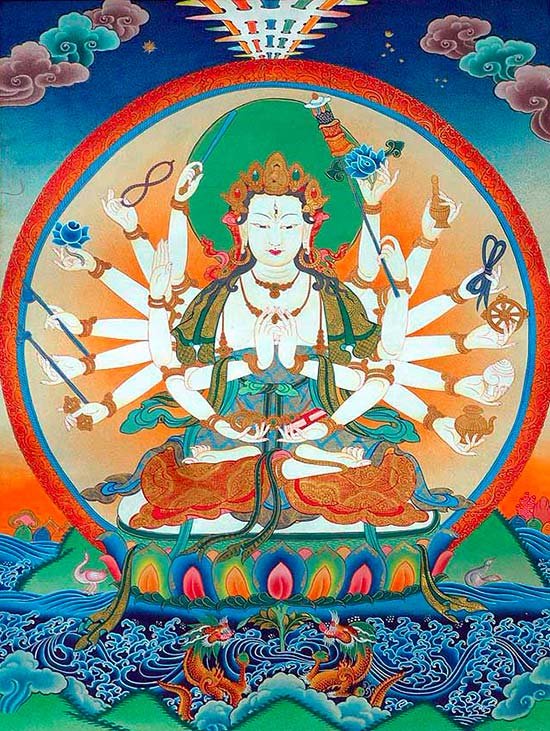Maha Prajnaparamita Sastra
by Gelongma Karma Migme Chödrön | 2001 | 941,039 words
This page describes “setting out on the mahayana” as written by Nagarjuna in his Maha-prajnaparamita-sastra (lit. “the treatise on the great virtue of wisdom”) in the 2nd century. This book, written in five volumes, represents an encyclopedia on Buddhism as well as a commentary on the Pancavimsatisahasrika Prajnaparamita.
Chapter XX - (2nd series): Setting out on the Mahāyāna
- Sub-Contents: (+ / -)
Sūtra. – Atha khalu bhagavān āyuṣmantaṃ subhūtim etad avocat | yad api subhūtir evam āha | kathaṃ bodhisattvo mahāsattvo mahāyānasaṃprasthito bhavati | iha subhūte bodhisattvo mahāsattvaḥ ṣaṭsu pāramitāsu caran bhūmer bhūmiṃ saṃkrāmati | ayaṃ bodhisattvo mahāsattvo mahāyāna-saṃprasthita ity ucyate |
athāyuṣmān subhūtir bhagavantam etad avocat | kathaṃ bhagavan bodhisattvo mahāsattvo bhūmer bhūmin saṃkrāmati | bhagavān āha | bodhisattvo mahāsattvaḥ sarvadharmāṇām asaṃkrāntim jānāti | na hi kaścid dharmo ya āgacchati vā gacchati vā saṃkrāmati vā upasaṃkrāmati vā | api tu bodhisattva yā sarvadharmāṇaṃ bhūmis tāṃ na manyate na cintayati bhūmiparikarma ca karoti na ca bhūmiṃ samanupaśyati |
Then the Blessed One said to venerable Subhūti: You also asked me, O Subhūti, how the bodhisattva-mahāsattva sets out on the Mahāyāna. Well then, Subhūti, the bodhisattva-mahāsattva who, going along with the six perfections, passes from ground to ground is said to have set out on the Mahāyāna.
Then the venerable Subhūti said to the Blessed One: How, O Blessed One, does the bodhisattva-mahāsattva pass from ground to ground? – The Blessed One answered: The bodhisattva-mahāsattva knows the non-passing of all the dharmas; indeed, there is no dharma that comes or that goes, that passes by or that approaches. However, the bodhisattva-mahāsattva does not think, does not reflect about the level of the dharmas and yet he practices the preparations for the grounds but does not see the grounds.
Śāstra (p. 411a16). – Above (Pañcaviṃśati, p. 194), Subhūti had questioned the Buddha about the Mahāyāna, and the Buddha had answered (ibid., p. 194–214) by explaining the many characteristics of the Mahāyāna to him (see note below). Also above (ibid., p. 214), Subhūti had asked a question about starting out for the Mahāyāna (mahāyānasaṃprasthaÌa) and here also the Buddha answered about the characteristics of this setting out.
The bodhisattva-mahāsattva going in this Vehicle (yānarūḍha) knows that from the beginning (ādita eva) all dharmas are without coming (anāgama), without going (anirgama), unmoving (acala) and without setting forth (asaṃprasthāna), because the fundamental element is eternally stable (sthita).
Furthermore, by minds of great compassion (mahākaruṇācitta), by the perfection of exertion (vīryapāramitā) and by the power of skillful means (upāyabala), the bodhisattva returns to practice the good dharmas (kuśaladharma) and, still seeking the higher grounds (uttarabhūmi),[1] he does not grasp the characteristics of these grounds (na bhūminimittāny udgṛhnāti) and does not see these grounds.
Question. – But [in order to answer Subhūti’s question precisely], the Buddha should have spoken here about the Greater Vehicle (mahāyānasaṃprasthāna); why then does he speak about setting out for the grounds (bhūmisaṃprasthāna)?
Answer. – The Greater Vehicle is the grounds; [thus, to speak about the grounds is to speak about the Greater Vehicle]. The grounds are ten in number; to go from the first to the tenth is to ‘start out’ (saṃprasthāna). Thus a man riding on a horse (aśva) who wants to ride on an elephant (hastin), abandons the horse and gets up on the elephant; and to ride on a dragon (nāga), he abandons the elephant and mounts the dragon.
Question. – What are the ten grounds?
Answer. – There are two kinds of grounds: i) the grounds belonging to the bodhisattva (bodhisattvabhūmi) alone, ii) the shared grounds (sādhāraṇabhūmi).[2]
The shared grounds go from the ground of d ry seeing (śuṣkavidarśanābhūmi) to the ground of the Buddhas (buddhabhūmi).
The grounds belonging to the bodhisattva alone are:
- the joyous ground (pramuditā bhūmi),
- the stainless ground (vimalā bhūmi),
- the shining ground (prabhākarī bhūmi),
- the ground of fiery wisdom (arciṣmati bhūmi),
- the ground difficult to conquer (sudurjayā bhūmi),
- the ground of presence (abhimukhī bhūmi),
- the far-gone ground (dūraṃgamā bhūmi),
- the unshakeable ground (acalā bhūmi),
- the ground of good wisdom (sādhumatī bhūmi)
- the ground of the cloud of the Dharma (dharmameghā bhūmi).
For the characteristics of these grounds, see the full explanation in the Che-ti king (Daśabhūmika sūtra).
Notes on the characteristics of the Mahāyāna:
According to the Pañcaviṃśati (p. 194–225), the many characteristics of the Mahāyāna are classified in the following way:
1. the six pāramitās (p. 194–195).
2. the twenty śūnyatās (p. 195–198).
3. the one hundred ands twelve samādhis (p. 198–203).
4. the twenty-one groups of practices (p. 203–212): 1) four smṛtyupasthānas, 2) four samyakprahānas, 3) four ṛddhipādas, 4) five indriyas, 5) five balas, 6) seven bodhyaṅgas, 7) aṣṭāṅgamārga, 8) three samādhis, 9) eleven jñānas, 10) three indriyas, 11) three samādhis, 12) ten anusmṛtis, 13) four dhyānas, 14) four apramāṇas, 15) four samāpattis, 16) eight vimokṣas, 17) nine anupūrvavihāras, 18) ten tathāgatabalas, 19) four vaiśāradyas, 20) four pratisaṃvids, 21) eighteen āveṇika buddhadharmas.
5. the forty-three dhāraṇimukhas (p. 212–214).
6. the ten bhūmis (p. 214–225).
Footnotes and references:
[1]:
Bhūmis 8 to 10.
[2]:
See the preliminary note to this chapter.
